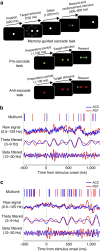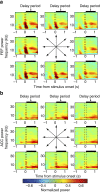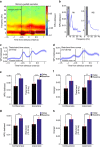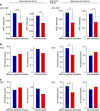Theta and beta synchrony coordinate frontal eye fields and anterior cingulate cortex during sensorimotor mapping
- PMID: 28169987
- PMCID: PMC5309702
- DOI: 10.1038/ncomms13967
Theta and beta synchrony coordinate frontal eye fields and anterior cingulate cortex during sensorimotor mapping
Abstract
The frontal eye fields (FEFs) and the anterior cingulate cortex (ACC) are commonly coactivated for cognitive saccade tasks, but whether this joined activation indexes coordinated activity underlying successful guidance of sensorimotor mapping is unknown. Here we test whether ACC and FEF circuits coordinate through phase synchronization of local field potential and neural spiking activity in macaque monkeys performing memory-guided and pro- and anti-saccades. We find that FEF and ACC showed prominent synchronization at a 3-9 Hz theta and a 12-30 Hz beta frequency band during the delay and preparation periods with a strong Granger-causal influence from ACC to FEF. The strength of theta- and beta-band coherence between ACC and FEF but not variations in power predict correct task performance. Taken together, the results support a role of ACC in cognitive control of frontoparietal networks and suggest that narrow-band theta and to some extent beta rhythmic activity indexes the coordination of relevant information during periods of enhanced control demands.
Conflict of interest statement
Springer Nature remains neutral with regard to jurisdictional claims in published maps and institutional affiliations.
The authors declare no competing financial interests.
Figures








Similar articles
-
Simultaneous analysis of the LFP and spiking activity reveals essential components of a visuomotor transformation in the frontal eye field.Proc Natl Acad Sci U S A. 2017 Jun 13;114(24):6370-6375. doi: 10.1073/pnas.1703809114. Epub 2017 Jun 1. Proc Natl Acad Sci U S A. 2017. PMID: 28572407 Free PMC article.
-
Theta-gamma coordination between anterior cingulate and prefrontal cortex indexes correct attention shifts.Proc Natl Acad Sci U S A. 2015 Jul 7;112(27):8457-62. doi: 10.1073/pnas.1500438112. Epub 2015 Jun 22. Proc Natl Acad Sci U S A. 2015. PMID: 26100868 Free PMC article.
-
Impairment of decision making and disruption of synchrony between basolateral amygdala and anterior cingulate cortex in the maternally separated rat.Neurobiol Learn Mem. 2016 Dec;136:74-85. doi: 10.1016/j.nlm.2016.09.015. Epub 2016 Sep 21. Neurobiol Learn Mem. 2016. PMID: 27664716
-
Anterior Cingulate Cortex and the Control of Dynamic Behavior in Primates.Curr Biol. 2020 Dec 7;30(23):R1442-R1454. doi: 10.1016/j.cub.2020.10.009. Curr Biol. 2020. PMID: 33290716 Free PMC article. Review.
-
Monitoring and control of action by the frontal lobes.Neuron. 2002 Oct 10;36(2):309-22. doi: 10.1016/s0896-6273(02)00964-9. Neuron. 2002. PMID: 12383784 Review.
Cited by
-
Frequency-specific coupling in fronto-parieto-occipital cortical circuits underlie active tactile discrimination.Sci Rep. 2019 Mar 25;9(1):5105. doi: 10.1038/s41598-019-41516-3. Sci Rep. 2019. PMID: 30911025 Free PMC article.
-
Associations of Alpha and Beta Interhemispheric EEG Coherences with Indices of Attentional Control and Academic Performance.Behav Neurol. 2020 Feb 5;2020:4672340. doi: 10.1155/2020/4672340. eCollection 2020. Behav Neurol. 2020. PMID: 32089751 Free PMC article.
-
Layer-specific pyramidal neuron properties underlie diverse anterior cingulate cortical motor and limbic networks.Cereb Cortex. 2022 May 14;32(10):2170-2196. doi: 10.1093/cercor/bhab347. Cereb Cortex. 2022. PMID: 34613380 Free PMC article.
-
Intermittent Theta Burst Stimulation of the Prefrontal Cortex in Cocaine Use Disorder: A Pilot Study.Front Neurosci. 2019 Jul 25;13:765. doi: 10.3389/fnins.2019.00765. eCollection 2019. Front Neurosci. 2019. PMID: 31402851 Free PMC article.
-
A theta rhythm in macaque visual cortex and its attentional modulation.Proc Natl Acad Sci U S A. 2018 Jun 12;115(24):E5614-E5623. doi: 10.1073/pnas.1719433115. Epub 2018 May 30. Proc Natl Acad Sci U S A. 2018. PMID: 29848632 Free PMC article.
References
-
- Wurtz R. H & Mohler C. W. Enhancement of visual responses in monkey striate cortex and frontal eye fields. J. Neurophysiol. 39, 766–772 (1976). - PubMed
-
- Bruce C. J., Goldberg M. E., Bushnell M. C. & Stanton G. B. Primate frontal eye fields. II. Physiological and anatomical correlates of electrically evoked eye movements. J. Neurophysiol. 54, 714–734 (1985). - PubMed
-
- Moore T. & Armstrong K. M. Selective gating of visual signals by microstimulation of frontal cortex. Nature 421, 370–373 (2003). - PubMed
Publication types
MeSH terms
LinkOut - more resources
Full Text Sources
Other Literature Sources

